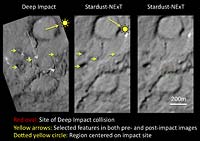|
COMETS EARTH JUPITER KUIPER BELT MARS MERCURY METEORITES NEPTUNE OORT CLOUD PLUTO SATURN SOLAR SYSTEM SPACE SUN URANUS VENUS ORDER PRINTS
PHOTO CATEGORIES SCIENCEVIEWS AMERICAN INDIAN AMPHIBIANS BIRDS BUGS FINE ART FOSSILS THE ISLANDS HISTORICAL PHOTOS MAMMALS OTHER PARKS PLANTS RELIGIOUS REPTILES SCIENCEVIEWS PRINTS
|
Related Documents
Download Options
This image shows the surface of comet Tempel 1 as seen before and after NASA's Deep Impact mission sent a probe into the comet in 2005. The region was imaged by Deep Impact before the collision (left), then six years later on Feb. 14, 2011, by NASA's Stardust-NExT mission, which flew by the comet, snapping pictures along the way (middle and right images). The white arrow shows the trajectory of the impact probe, and the red oval shows the area of impact, based on the trajectory data. The large yellow arrows show the location of the sun, while the little yellow arrows show selected features in the both the pre- and post-impact images. The yellow dotted circle shows the region of the impact site. Scientists are still analyzing the disturbance to the surface on comet Tempel 1 where the Deep Impact collision occurred. Stardust-NExT is a low-cost mission that is expanding the investigation of comet Tempel 1 initiated by NASA's Deep Impact spacecraft. NASA's Jet Propulsion Laboratory, a division of the California Institute of Technology in Pasadena, manages Stardust-NExT for the NASA Science Mission Directorate, Washington, D.C. Joe Veverka of Cornell University, Ithaca, N.Y., is the mission's principal investigator. Lockheed Martin Space Systems, Denver, built the spacecraft and manages day-to-day mission operations. |
